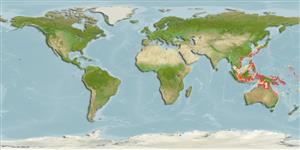Common names from other countries
>
Gobiiformes (Gobies) >
Gobiidae (Gobies) > Gobiinae
Etymology: Ancistrogobius: Name from Greek word 'agkistros' meaning fishhook and Gobius , a genus name of gobiine fish, in reference to the short, ventrally directed, spur-like preopercular spine.; dipus: Name from Greek words 'dis' meaning two and 'pous' for foot. referring to its largely separated pelvic fins..
Environment: milieu / climate zone / depth range / distribution range
Ekologi
laut bentopelagis; kisaran kedalaman 15 - 35 m (Ref. 84001). Subtropical
Western Pacific: Japan to the Great Barrier Reef.
Size / Weight / umur
Maturity: Lm ? range ? - ? cm
Max length : 4.2 cm SL jantan/; (Ref. 84001)
deskripsi pendek
Kunci identifiaksi (pengenalan) | Morfologi | Morfometrik
Duri punggung (Keseluruhan (total)) : 7; duri punggung lunak (Keseluruhan (total)) : 9 - 10; Duri dubur: 1; Sirip dubur lunak: 9. This species is unique from its congeners by having the following characters: largely separated pelvic fin with rudimentary connecting membrane and no frenum; fifth segmented ray of pelvic fin short, length 67.9-71.9% of preceding ray; a narrow black blotch on distal tip of
first dorsal fin (not reaching posteriorly to third spine); pectoral-fin rays 19-21, usually 20; head and most of nape naked, no predorsal scales (except for one specimen, WAM-P.32537-001, with one predorsal scale); third spine of first dorsal fin greatly elongated, filamentous, obviously longer than preceding spine, typically with alternating pale and dusky (or yellow) bands when alive or fresh; faint, dusky blotches (not forming distinct vertical bar) below eye; sensory papilla x^1 and x^2 not continuous, interrupted by row trp; sensory papilla rows trp long, extending dorsally to well above a longitudinal line through row x^1; anterior tip of sensory papilla row b meeting row 4; sensory papilla row 4 long, dorsal tip close to eye; possess a relatively slender and pointed snout (this character difficult to quantify) (Ref. 84001).
Collected from sandy-mud or silt bottoms with dead-coral rubble at depths of 15-35 m (Ref. 84001).
Life cycle and mating behavior
Maturities | Reproduksi, perkembang biakan | Spawnings | Egg(s) | Fecundities | Larva
Shibukawa, K., T. Yoshino and G.R. Allen, 2010. Ancistrogobius, a new cheek-spine goby genus from the West Pacific and Red Sea, with descriptions of four new species (Perciformes: Gobiidae: Gobiinae). Bull. Natl. Mus. Nat. Sci., Ser. A, (Suppl. 4):67-87. (Ref. 84001)
Status IUCN Red List (Ref. 130435)
CITES (Ref. 128078)
Not Evaluated
ancaman kepada manusia
Harmless
penggunaan manusia
Alat, peralatan
laporan khas
muat turun XML
Sumber internet
Estimates based on models
Preferred temperature (Ref.
115969): 25 - 28.9, mean 27.9 (based on 96 cells).
Phylogenetic diversity index (Ref.
82804): PD
50 = 0.5625 [Uniqueness, from 0.5 = low to 2.0 = high].
Bayesian length-weight: a=0.00708 (0.00333 - 0.01504), b=3.09 (2.92 - 3.26), in cm Total Length, based on LWR estimates for this (Sub)family-body shape (Ref.
93245).
Trophic level (Ref.
69278): 3.2 ±0.3 se; based on size and trophs of closest relatives
Daya lenting (Ref.
120179): Tinggi, Waktu penggandaan populasi minimum kurang dari 15 bulan (Preliminary K or Fecundity.).
Fishing Vulnerability (Ref.
59153): Low vulnerability (10 of 100).
